The focus groups based upon ViewGroups still work within ConstraintLayout, so you could replace LinearLayouts and RelativeLayouts with ConstraintLayouts and TalkBack will still work as expected. But, if you are trying to avoid nesting ViewGroups within ConstraintLayout, keeping with the design goal of a flat view hierarchy, here is a way to do it.
Move the TextViews from the focus ViewGroup that you mention directly into the top-level ConstraintLayout. Now we will place a simple transparent View on top of these TextViews using ConstraintLayout constraints. Each TextView will be a member of the top-level ConstraintLayout, so the layout will be flat. Since the overlay is on top of the TextViews, it will receive all touch events before the underlying TextViews. Here is the layout structure:
<ConstaintLayout>
<TextView>
<TextView>
<TextView>
<View> [overlays the above TextViews]
</ConstraintLayout>
We can now manually specify a content description for the overlay that is a combination of the text of each of the underlying TextViews. To prevent each TextView from accepting focus and speaking its own text, we will set android:importantForAccessibility="no". When we touch the overlay view, we hear the combined text of the TextViews spoken.
The preceding is the general solution but, better yet, would be an implementation of a custom overlay view that will manage things automatically. The custom overlay shown below follows the general syntax of the Group helper in ConstraintLayout and automates much of the processing outlined above.
The custom overlay does the following:
- Accepts a list of ids that will be grouped by the control like the
Group helper of ConstraintLayout.
- Disables accessibility for the grouped controls by setting
View.setImportantForAccessibility(IMPORTANT_FOR_ACCESSIBILITY_NO) on each view. (This avoids having to do this manually.)
- When clicked, the custom control presents a concatenation of the text of grouped views to the accessibility framework. The text collected for a view is either from the
contentDescription, getText() or the hint. (This avoids having to do this manually. Another advantage is that it will also pick up any changes made to the text while the app is running.)
The overlay view still needs to be positioned manually within the layout XML to overlay the TextViews.
Here is a sample layout showing the ViewGroup approach mentioned in the question and the custom overlay. The left group is the traditional ViewGroup approach demonstrating the use of an embedded ConstraintLayout; The right is the overlay method using the custom control. The TextView on top labeled "initial focus" is just there to capture the initial focus for ease of comparing the two methods.
With the ConstraintLayout selected, TalkBack speaks "Artist, Song, Album".

With the custom view overlay selected, TalkBack also speaks "Artist, Song, Album".

Below is the sample layout and the code for the custom view. Caveat: Although this custom view works for the stated purpose using TextViews, it is not a robust replacement for the traditional method. For example: The custom overlay will speak the text of view types extending TextView such as EditText while the traditional method does not.
See the sample project on GitHub.
activity_main.xml
<android.support.constraint.ConstraintLayout
android:id="@+id/layout"
android:layout_width="match_parent"
android:layout_height="match_parent">
<android.support.constraint.ConstraintLayout
android:id="@+id/viewGroup"
android:layout_width="0dp"
android:layout_height="wrap_content"
android:focusable="true"
android:gravity="center_horizontal"
app:layout_constraintEnd_toStartOf="@+id/guideline"
app:layout_constraintStart_toStartOf="parent"
app:layout_constraintTop_toBottomOf="@+id/viewGroupHeading">
<TextView
android:id="@+id/artistText"
android:layout_width="wrap_content"
android:layout_height="wrap_content"
android:text="Artist"
app:layout_constraintEnd_toEndOf="parent"
app:layout_constraintStart_toStartOf="parent"
app:layout_constraintTop_toTopOf="parent" />
<TextView
android:id="@+id/songText"
android:layout_width="wrap_content"
android:layout_height="wrap_content"
android:layout_marginTop="16dp"
android:text="Song"
app:layout_constraintStart_toStartOf="@+id/artistText"
app:layout_constraintTop_toBottomOf="@+id/artistText" />
<TextView
android:id="@+id/albumText"
android:layout_width="wrap_content"
android:layout_height="wrap_content"
android:layout_marginTop="16dp"
android:text="Album"
app:layout_constraintStart_toStartOf="@+id/songText"
app:layout_constraintTop_toBottomOf="@+id/songText" />
</android.support.constraint.ConstraintLayout>
<TextView
android:id="@+id/artistText2"
android:layout_width="wrap_content"
android:layout_height="wrap_content"
android:text="Artist"
app:layout_constraintBottom_toTopOf="@+id/songText2"
app:layout_constraintEnd_toEndOf="parent"
app:layout_constraintStart_toStartOf="@+id/guideline"
app:layout_constraintTop_toTopOf="@+id/viewGroup" />
<TextView
android:id="@+id/songText2"
android:layout_width="wrap_content"
android:layout_height="wrap_content"
android:layout_marginTop="16dp"
android:text="Song"
app:layout_constraintStart_toStartOf="@id/artistText2"
app:layout_constraintTop_toBottomOf="@+id/artistText2" />
<TextView
android:id="@+id/albumText2"
android:layout_width="wrap_content"
android:layout_height="wrap_content"
android:layout_marginTop="16dp"
android:text="Album"
app:layout_constraintStart_toStartOf="@+id/artistText2"
app:layout_constraintTop_toBottomOf="@+id/songText2" />
<com.example.constraintlayoutaccessibility.AccessibilityOverlay
android:id="@+id/overlay"
android:layout_width="0dp"
android:layout_height="0dp"
android:focusable="true"
app:accessible_group="artistText2, songText2, albumText2, editText2, button2"
app:layout_constraintBottom_toBottomOf="@+id/albumText2"
app:layout_constraintEnd_toEndOf="parent"
app:layout_constraintStart_toEndOf="@id/guideline"
app:layout_constraintTop_toTopOf="@id/viewGroup" />
<android.support.constraint.Guideline
android:id="@+id/guideline"
android:layout_width="wrap_content"
android:layout_height="wrap_content"
android:orientation="vertical"
app:layout_constraintGuide_percent="0.5" />
<TextView
android:id="@+id/viewGroupHeading"
android:layout_width="wrap_content"
android:layout_height="wrap_content"
android:layout_marginTop="16dp"
android:importantForAccessibility="no"
android:text="ViewGroup"
android:textAppearance="@style/TextAppearance.AppCompat.Medium"
android:textStyle="bold"
app:layout_constraintEnd_toStartOf="@+id/guideline"
app:layout_constraintStart_toStartOf="parent"
app:layout_constraintTop_toBottomOf="@+id/textView4" />
<TextView
android:id="@+id/overlayHeading"
android:layout_width="wrap_content"
android:layout_height="wrap_content"
android:importantForAccessibility="no"
android:text="Overlay"
android:textAppearance="@style/TextAppearance.AppCompat.Medium"
android:textStyle="bold"
app:layout_constraintEnd_toEndOf="parent"
app:layout_constraintStart_toStartOf="@+id/guideline"
app:layout_constraintTop_toTopOf="@+id/viewGroupHeading" />
<TextView
android:id="@+id/textView4"
android:layout_width="wrap_content"
android:layout_height="wrap_content"
android:layout_marginStart="8dp"
android:layout_marginTop="8dp"
android:layout_marginEnd="8dp"
android:text="Initial focus"
app:layout_constraintEnd_toStartOf="@+id/guideline"
app:layout_constraintStart_toStartOf="@+id/guideline"
app:layout_constraintTop_toTopOf="parent" />
</android.support.constraint.ConstraintLayout>
AccessibilityOverlay.java
public class AccessibilityOverlay extends View {
private int[] mAccessibleIds;
public AccessibilityOverlay(Context context) {
super(context);
init(context, null, 0, 0);
}
public AccessibilityOverlay(Context context, @Nullable AttributeSet attrs) {
super(context, attrs);
init(context, attrs, 0, 0);
}
public AccessibilityOverlay(Context context, @Nullable AttributeSet attrs, int defStyleAttr) {
super(context, attrs, defStyleAttr);
init(context, attrs, defStyleAttr, 0);
}
@TargetApi(Build.VERSION_CODES.LOLLIPOP)
public AccessibilityOverlay(Context context, @Nullable AttributeSet attrs,
int defStyleAttr, int defStyleRes) {
super(context, attrs, defStyleAttr, defStyleRes);
init(context, attrs, defStyleAttr, defStyleRes);
}
private void init(Context context, @Nullable AttributeSet attrs,
int defStyleAttr, int defStyleRes) {
String accessibleIdString;
TypedArray a = context.getTheme().obtainStyledAttributes(
attrs,
R.styleable.AccessibilityOverlay,
defStyleAttr, defStyleRes);
try {
accessibleIdString = a.getString(R.styleable.AccessibilityOverlay_accessible_group);
} finally {
a.recycle();
}
mAccessibleIds = extractAccessibleIds(context, accessibleIdString);
}
@NonNull
private int[] extractAccessibleIds(@NonNull Context context, @Nullable String idNameString) {
if (TextUtils.isEmpty(idNameString)) {
return new int[]{};
}
String[] idNames = idNameString.split(ID_DELIM);
int[] resIds = new int[idNames.length];
Resources resources = context.getResources();
String packageName = context.getPackageName();
int idCount = 0;
for (String idName : idNames) {
idName = idName.trim();
if (idName.length() > 0) {
int resId = resources.getIdentifier(idName, ID_DEFTYPE, packageName);
if (resId != 0) {
resIds[idCount++] = resId;
}
}
}
return resIds;
}
@Override
public void onAttachedToWindow() {
super.onAttachedToWindow();
View view;
ViewGroup parent = (ViewGroup) getParent();
for (int id : mAccessibleIds) {
if (id == 0) {
break;
}
view = parent.findViewById(id);
if (view != null) {
view.setImportantForAccessibility(IMPORTANT_FOR_ACCESSIBILITY_NO);
}
}
}
@Override
public void onPopulateAccessibilityEvent(AccessibilityEvent event) {
super.onPopulateAccessibilityEvent(event);
int eventType = event.getEventType();
if (eventType == AccessibilityEvent.TYPE_VIEW_SELECTED ||
eventType == AccessibilityEvent.TYPE_VIEW_ACCESSIBILITY_FOCUSED &&
getContentDescription() == null) {
event.getText().add(getAccessibilityText());
}
}
@NonNull
private String getAccessibilityText() {
ViewGroup parent = (ViewGroup) getParent();
View view;
StringBuilder sb = new StringBuilder();
for (int id : mAccessibleIds) {
if (id == 0) {
break;
}
view = parent.findViewById(id);
if (view != null && view.getVisibility() == View.VISIBLE) {
CharSequence description = view.getContentDescription();
// This misbehaves if the view is an EditText or Button or otherwise derived
// from TextView by voicing the content when the ViewGroup approach remains
// silent.
if (TextUtils.isEmpty(description) && view instanceof TextView) {
TextView tv = (TextView) view;
description = tv.getText();
if (TextUtils.isEmpty(description)) {
description = tv.getHint();
}
}
if (description != null) {
sb.append(",");
sb.append(description);
}
}
}
return (sb.length() > 0) ? sb.deleteCharAt(0).toString() : "";
}
private static final String ID_DELIM = ",";
private static final String ID_DEFTYPE = "id";
}
attrs.xml
Define the custom attributes for the custom overlay view.
<resources>
<declare-styleable name="AccessibilityOverlay">
<attr name="accessible_group" format="string" />
</declare-styleable>
</resources>


